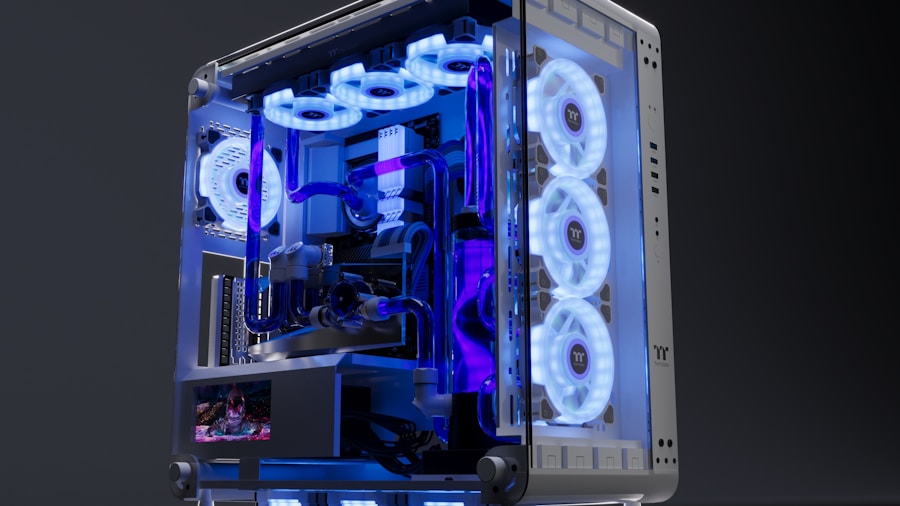Cooling technologies have become an essential part of our daily lives, from keeping our homes and offices at a comfortable temperature to preserving food and medicine. The development of cooling technologies has come a long way since the invention of the first ice-making machine in the 19th century. Today, we have a wide range of refrigeration and air conditioning systems that use various methods to cool and regulate temperature. These technologies have not only improved our quality of life but also have significant implications for the environment and sustainability. In this article, we will explore the advancements in cooling technologies, innovative materials and designs, sustainable solutions, the role of artificial intelligence, and future trends in the field.
Advancements in Refrigeration and Air Conditioning
Refrigeration and air conditioning have seen significant advancements in recent years, with a focus on energy efficiency and environmental impact. Traditional refrigerants such as chlorofluorocarbons (CFCs) and hydrochlorofluorocarbons (HCFCs) have been phased out due to their harmful effects on the ozone layer and contribution to global warming. Newer refrigerants such as hydrofluorocarbons (HFCs) and hydrofluoroolefins (HFOs) have been developed to replace them, with a much lower impact on the environment. In addition to the shift towards more environmentally friendly refrigerants, there has been a focus on improving the energy efficiency of refrigeration and air conditioning systems. This has led to the development of advanced compressors, heat exchangers, and controls that can significantly reduce energy consumption while maintaining optimal cooling performance.
Another significant advancement in refrigeration and air conditioning is the development of variable refrigerant flow (VRF) systems. VRF systems use advanced technology to modulate the flow of refrigerant to different indoor units based on the cooling or heating demand in each zone. This allows for precise temperature control and energy savings compared to traditional HVAC systems. Furthermore, advancements in heat pump technology have made it possible to use refrigeration systems for both heating and cooling, providing a more versatile and efficient solution for buildings. Overall, these advancements in refrigeration and air conditioning have led to more sustainable and energy-efficient cooling solutions for various applications.
Innovative Cooling Materials and Designs
In addition to advancements in refrigeration and air conditioning systems, there have been significant developments in cooling materials and designs. One innovative approach to cooling is the use of phase change materials (PCMs) that can store and release thermal energy during phase transitions. PCMs can be integrated into building materials, clothing, or packaging to provide passive cooling or heating without the need for external energy sources. This technology has the potential to reduce the energy consumption of buildings and improve thermal comfort in various applications.
Another innovative cooling material is aerogel, which is a highly porous solid material with low thermal conductivity. Aerogels can be used as insulation in refrigeration systems, buildings, and vehicles to reduce heat transfer and improve energy efficiency. Additionally, advancements in micro- and nanotechnology have led to the development of novel cooling designs such as microchannel heat exchangers and microscale refrigeration systems. These designs offer improved heat transfer performance and compactness, making them suitable for various cooling applications. Overall, innovative cooling materials and designs have the potential to revolutionize the way we cool our buildings, appliances, and transportation systems.
Sustainable Cooling Solutions
As concerns about climate change and environmental sustainability continue to grow, there is a growing demand for sustainable cooling solutions. One approach to sustainable cooling is the use of natural refrigerants such as carbon dioxide (CO2) and ammonia (NH3) that have low global warming potential and ozone depletion potential. These natural refrigerants are being used in commercial refrigeration systems, heat pumps, and air conditioning units as a more environmentally friendly alternative to synthetic refrigerants. Additionally, there is a growing interest in the use of renewable energy sources such as solar power for cooling applications. Solar-powered refrigeration systems can provide off-grid cooling solutions for remote areas or during power outages, reducing reliance on fossil fuels and grid electricity.
Another sustainable cooling solution is the integration of passive cooling techniques into building design. Passive cooling techniques such as natural ventilation, shading, and thermal mass can reduce the need for mechanical cooling systems and lower energy consumption. Furthermore, advancements in building envelope materials and insulation can improve thermal performance and reduce heat gain, leading to more energy-efficient buildings. Overall, sustainable cooling solutions aim to minimize the environmental impact of cooling technologies while meeting the growing demand for comfort and convenience.
The Role of Artificial Intelligence in Cooling Systems
Artificial intelligence (AI) has become increasingly integrated into cooling systems to improve efficiency, performance, and user experience. AI algorithms can optimize the operation of refrigeration and air conditioning systems by analyzing data from sensors, weather forecasts, and user preferences to adjust cooling settings in real-time. This can lead to energy savings, improved comfort, and reduced maintenance costs for building owners and operators. Additionally, AI-powered predictive maintenance can identify potential issues in cooling systems before they occur, reducing downtime and extending equipment lifespan.
Furthermore, AI is being used to develop advanced control strategies for variable refrigerant flow (VRF) systems that can optimize temperature distribution based on occupancy patterns and thermal loads. This can lead to more precise temperature control, reduced energy consumption, and improved comfort for building occupants. AI is also being used to develop smart thermostats and building automation systems that can learn user behavior and adjust cooling settings automatically to maximize comfort while minimizing energy usage. Overall, AI has the potential to revolutionize the way we control and optimize cooling systems for maximum efficiency and user comfort.
Future Trends in Cooling Technologies
Looking ahead, there are several emerging trends in cooling technologies that have the potential to shape the future of the industry. One trend is the development of solid-state cooling technologies that use thermoelectric or electrocaloric effects to achieve cooling without moving parts or refrigerants. Solid-state cooling has the potential to be more compact, efficient, and environmentally friendly compared to traditional vapor compression systems. Another trend is the integration of internet of things (IoT) technology into cooling systems to enable remote monitoring, control, and predictive maintenance. IoT-enabled cooling systems can provide real-time data on performance, energy usage, and equipment health to optimize operation and reduce downtime.
Furthermore, there is a growing interest in the development of personalized cooling solutions that can tailor temperature settings based on individual preferences and comfort requirements. This can be achieved through wearable devices or smart environments that can adjust cooling settings based on biometric data or user input. Additionally, advancements in material science are leading to the development of novel thermal management materials such as metamaterials that can manipulate heat transfer at the nanoscale for improved efficiency. Overall, future trends in cooling technologies are focused on improving efficiency, user experience, and environmental sustainability.
The Impact of Cooling on Climate Change
While cooling technologies have greatly improved our quality of life, they also have a significant impact on climate change. The use of synthetic refrigerants in refrigeration and air conditioning systems has contributed to global warming through direct emissions as well as indirect emissions from energy consumption. The phase-out of high global warming potential refrigerants such as HFCs is crucial for mitigating their impact on climate change. Additionally, the energy consumption of cooling systems contributes to greenhouse gas emissions from power generation, making energy efficiency a key factor in reducing their environmental impact.
Furthermore, the increasing demand for cooling due to urbanization, population growth, and climate change is putting additional strain on energy resources and exacerbating global warming. This has led to a growing concern about the “cooling gap” – the disparity between the need for cooling in developing countries and the availability of sustainable solutions. Addressing this gap will require a concerted effort to develop affordable, efficient, and environmentally friendly cooling technologies that can meet the growing demand without exacerbating climate change.
In conclusion, cooling technologies have come a long way from their humble beginnings to become an essential part of modern life. Advancements in refrigeration and air conditioning systems have led to more energy-efficient and environmentally friendly solutions. Innovative materials and designs are revolutionizing the way we cool our buildings and appliances. Sustainable cooling solutions are addressing the environmental impact of cooling technologies while meeting growing demand. The integration of artificial intelligence is optimizing the performance of cooling systems for maximum efficiency and user comfort. Looking ahead, future trends in cooling technologies are focused on improving efficiency, user experience, and environmental sustainability. However, it is crucial to address the impact of cooling on climate change by phasing out high global warming potential refrigerants, improving energy efficiency, and developing sustainable solutions for the growing demand for cooling.

![Roblox Digital Gift Code for 1,200 Robux [Redeem Worldwide - Includes Exclusive Virtual Item] [Online Game Code]](https://m.media-amazon.com/images/I/51m6xhkVu6L._SY430_SX215_QL70_ML2_.jpg)

